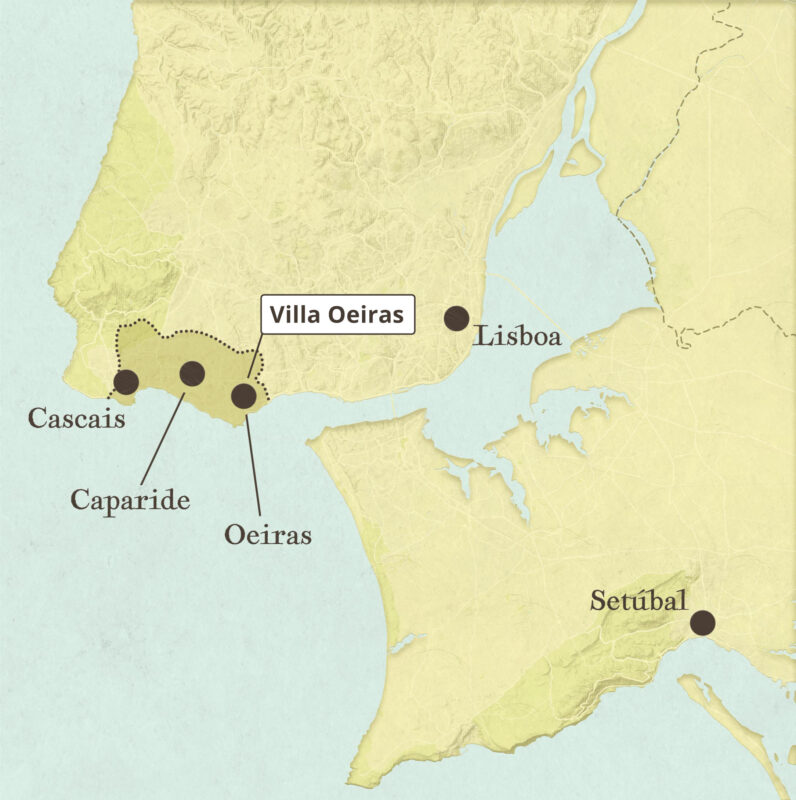CARCAVELOS, PORTUGAL
At 62 acres, Carcavelos is the smallest wine appellation in Portugal. Recognized as one of four great Portuguese Vinhos Generosos in 1908, along with Madeira, Porto and Moscatel de Setúbal, its wines first gained international reputation in the 18th century. Yet by the last decades of the 20th century, it appeared on the brink of extinction—with just 30 acres under vine—victim of its providential location, real estate development, and changing tastes in wine.
Carcavelos is produced from a blend of up to nine different white and red varieties. For the whites: Arinto, Gallego Dourado and Ratinho are most common; for the reds: Castelão and Trincadeira. Traditionally, the wines were fermented dry and subsequently fortified with vinho abafado (a fermented grape must, preserved by the addition of alcohol). Today, arresting the fermentation via mutage is the common practice. The resulting wine is typically 18-20% abv, with 80-100 g/l residual sugar, similar in sweetness to Port or a Boal Madeira. Elevage can range from 5-20 years, the wine becoming oxidative in character, with barrels more or less topped-up, depending on the style of the producer. Both vintage and blended age-statement are made.
Carcavelos vineyards are found in the municipalities of Oeiras and Cascais, west of Lisbon, along the Tagus estuary as it flows out to the Atlantic. Vines have been cultivated here since Roman times, and portions of its harvest were at one time shipped to the Douro to bolster the quality of Port wine production. Despite its acclaim, production of Carcavelos remained small relative to that of Port and Madeira, and the arrival of phylloxera in the late 19th century began the wine’s slow fade, even as the region was officially demarcated in 1908. Its fortunes further declined as vineyards were lost to redevelopment, and the wine nearly disappeared during the latter half of the 20th century.
By 1983, just two producers remained. Ministry of Agriculture officials stepped in to secure its future, protecting its remaining vineyards and establishing the first and only publicly owned winery in Portugal. Now owned by the municipality, Villa Oeiras is the sole active producer of Carcavelos. With its bottles rarely seen beyond Portuguese borders, Carcavelos is today amongst the rarest of wines and a fortified wine unlike any other.
VILLA OEIRAS CARCAVELOS, PORTUGAL
Villa Oeiras is the sole remaining producer of Carcavelos and was born of a partnership between the Ministry of Agriculture and municipality of Oeiras in 1983. Located in the former stables of the Marquis do Pombal at the Casal do Manteiga, its 30 acres are planted on calcareous soils just 200 meters from the Tagus estuary and comprise nearly half of the entire DOC. The vines are derived from original Pombal cuttings, material that traces its roots back more than three centuries. Arinto, Gallego Dourado and Ratinho form the backbone of its benchmark 15-year-old blend, and the signature of the Atlantic Ocean features prominently in its expression. The wines are aged in a combination of Nacional (Portuguese) and French oak, initially at the Casal do Manteiga, and are later transferred to the palatial cellars of the M. do Pombal for extended elevage. Under the direction of winemakers Tiago Correira, Pedro Sá and Alexandre Lisboa, Villa Oeiras is both sentinel and beacon of the Carcavelos appellation.


